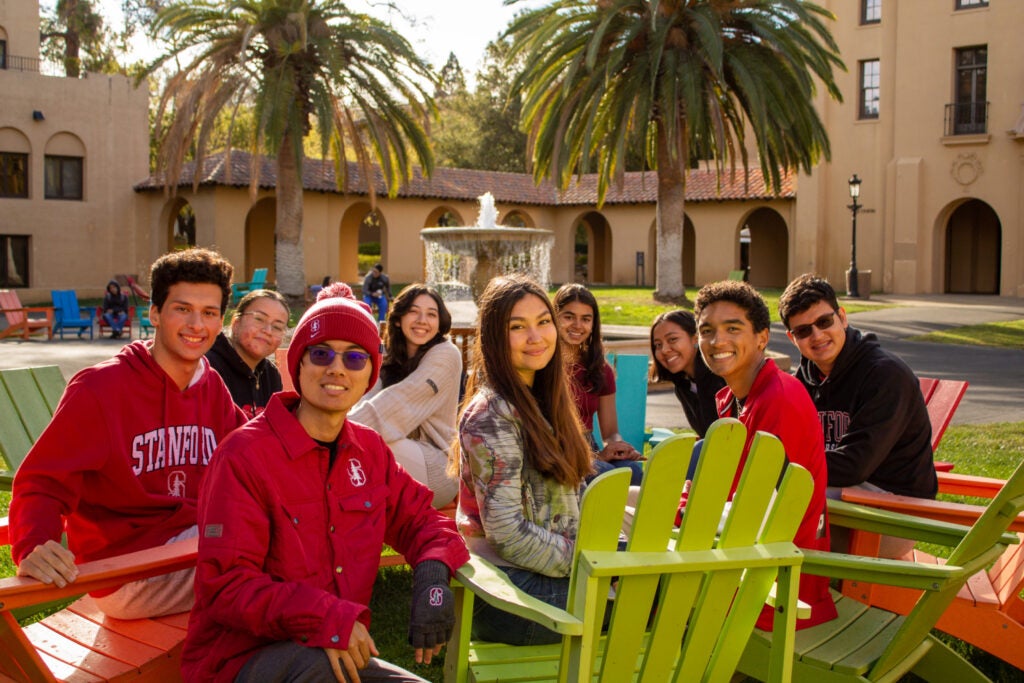Interns help power the success of neighborhoods
The student team builds momentum for the year’s many events, including this week’s Spring Fest and Dragfest.

Residential Education interns meet to discuss plans. (Image credit: Sydney Osifeso)
The newly renamed Stanford Neighborhoods are gearing up for the final gatherings of this academic year, with plenty of assistance from the 16 students who serve as paid interns helping build momentum for events through communications and programming.
For example, dorm events in the neighborhoods have helped increase the sense of community, said Olivia Viruet Quintero, Class of 2024. As the program intern for Aspen (A), part of her job is to communicate the funding decisions made by the neighborhood council regarding proposed events.
“There has definitely been an increase in the number of proposals each term,” Viruet Quintero said. She has seen proposals for everything from self-care events in the dorms to off-campus events such as a trip to Disneyland. “Students are more familiar with the system: how they’re able to get funding and get events approved.”
The neighborhood Instagram accounts, which are run by the communications interns, have also seen an increase in engagement this year.
Erin Ye, Class of 2026, the communications intern for Wisteria (F), said she gained more than 250 followers for her neighborhood account. She has also seen increasing engagement with her posts — especially event recaps, which students enjoy because they feature pictures and videos of them with their friends.
“My favorite part of the job is getting to showcase the community we have in our neighborhood,” Ye said. One highlight: Snow Day at Arguello Field. “People brought skis and snowboards and were playing in the snow. It was a lot of fun to take pictures and videos and post about it.”
A focus on communications
In addition to managing the neighborhood Instagram accounts, the communication interns create flyers for events and assist with neighborhood newsletters and Slack workspaces.
And many have had to find new ways to reach students. For example, neighborhood newsletters go out to all neighborhood residents every other week, but not everyone opens them. Interns were instrumental in experimenting with new ways of communicating, such as using Instagram stories to present highlights from the newsletters.
“These students are embedded in their communities and capture these events organically, with amazing photos and videos,” said Sydney Osifeso, associate director of administration for Residential Education.
The interns have also experimented to find the most effective ways to promote events to students. Paola Duran, Class of 2026 and the communications intern for Hyperion (T), said she posts on Instagram as an event is starting.
“Instagram stories have been the best way to get people to come out to events, especially when they’re right outside,” Duran said. “If they see that there are food trucks outside their dorm, they just want to be part of it.”
Bringing programs to life
The neighborhood program interns work with the professional staff to plan and execute neighborhood events, which can range from intimate gatherings in a house community to all-campus events at large venues.
“When we fund neighborhood events, I’m there helping, making sure the idea comes to life,” said Jaylon Jones, Class of 2026, the program intern for Redwood (R).
He has helped with events ranging from a Halloween costume contest to roller skating to a gathering with puppies for students to pet — and in doing so has learned what makes for a popular event.
“If I come to this event, if I take time away from studying and whatever other activities I have going on, there needs to be food, and there needs to be a bit of fun,” Jones said.
An enriching experience
During the year, the interns have also learned a lot about what goes into putting on an event.
“Seeing everything come together has been satisfying,” Viruet Quintero said. “To see the behind-the-scenes work of contacting vendors, trying to find a location, and then seeing the events happen is pretty cool.”
They’ve also seen how events can foster a sense of community and improve students’ experience. For example, Duran worked on a five-week winter wellness series of events that include tarot readings and massages.
“The idea was to show students some holistic practices that we can do to celebrate wellness,” Duran said. “I’ve heard that Winter Quarter is always the hardest, so it was nice to bring students together. Watching people leave those sessions, they were really calm and relaxed.”